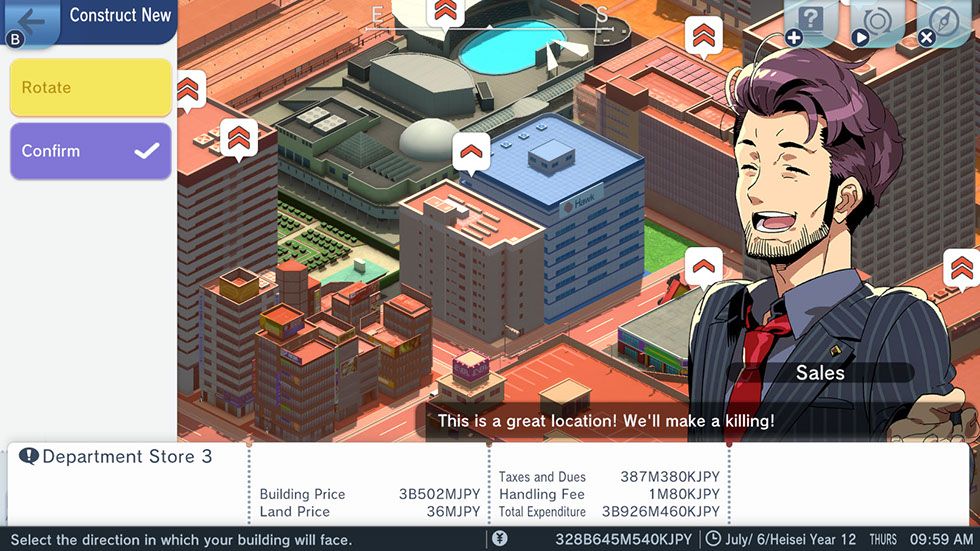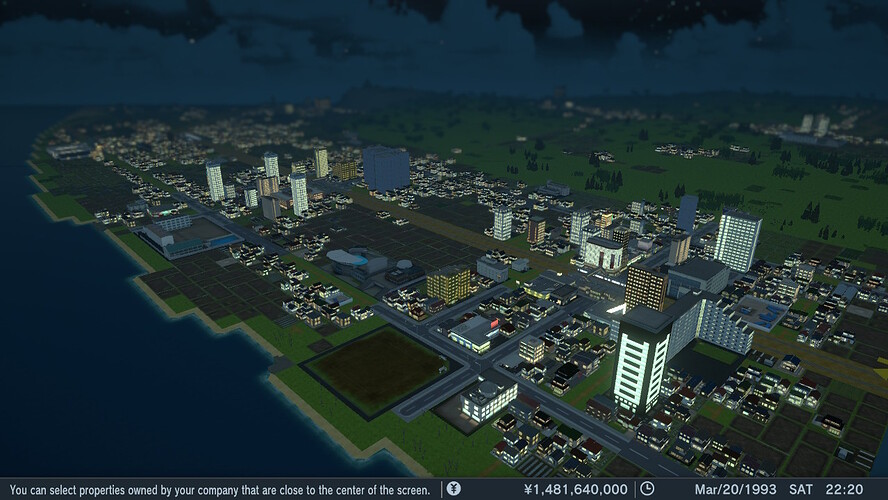There are a couple of things I end up tapping the screen for, but by and large, I’m just playing it normally handheld.
Recently acquired a Switch and the game a few days ago, so still learning the intricacies of A-Train: All Aboard! Tourism. However, my first impressions would be that it has the potential to be among the best games of the series in terms of gameplay. Proving to be just as complex and engaging as game director Masaki Iizuka’s previous entry in the series, A-Train 3D // A-Train PC Classic.
During pre-production the development team evaluated the strengths and weaknesses of the previous project, brainstormed several new themes that could be explored to expand the gameplay, and poured over fan feedback. Game director Masaki Iizuka considered several new ideas to expand upon the foundations of A-Train 3D // A-Train PC Classic and eventually settled upon the themes of Tourism and Sight-Seeing for the project.
As someone who enjoyed Railroad Tycoon II and III, I would personally opine that A-Train: All Aboard! Tourism would satisfy many fans of the Railroad Tycoon series. Both are deep, engaging and complex business games that feature challenging goal-driven scenarios. Through the use of tailored difficulty settings and advanced gameplay options this branch of A-Train games is able to cater to a wide-variety of skill levels.
Easy difficulty is tailored for people who want a thoughtful but relaxed experience with plenty of money, generous economic and company conditions, and ample time on offer to meet each scenario’s goals. In comparison, Normal and Hard difficulties unleash the full depth and complexity of the game upon players as gameplay elements such as economic instability, employee workload and satisfaction, and keeping your shareholders happy become ongoing concerns. With Hard difficulty offering the toughest test of your business management skills as advisor advice becomes disabled, money and objective time frames become tighter, and so on.
Obviously, the two games have their differences so they aren’t directly comparable in a number of areas, such as A-Train: All Aboard! Tourism not having rival competitors on the map. However, they definitely offer a comparable level of depth at simulating the business operations of a private railway company. Both games are the product of the history and influences that they seek to replicate. That means that A-Train has a greater emphasis on modeling regional and urban mass transit systems and city development due to the history of Japanese railroads in shaping the growth or establishment of entire Japanese towns and cities. Meanwhile, Railroad Tycoon III offers that more familiar, for western audiences, American and European model of railroading where industrialist tycoons and robber barons were often the key drivers.
However, what it abstracts or omits compared to Railroad Tycoon III in some aspects it more than makes up for with its depth and complexity in other areas. For example, passenger transport is heavily destination driven, meaning that tourists and residents will have destinations they want to travel to and therefore an interconnected system of transportation options (e.g., trains and buses) will not only have a wider ridership catchment area but is also more likely to cover destinations people want to get to. Throw in ridership levels varying across the 24-hour time cycle depending on the types of buildings in the station catchment area (e.g., residential and commerce) and efficient service scheduling becomes a major gameplay aspect for optimal play, similar to Traffic Giant or Cities in Motion. Plus since work days, weekends and public holidays are simulated these factors also affect ridership levels and the destinations people wish to travel to.
Honestly, there is so much I could explain about the gameplay depth of the two most recent entries in the series. However, the interconnected nature of the game’s mechanics might be best explained and shown through a Let’s Play format. Where I can first outline the basic mechanics and then layer in the purpose and usefulness of synergistic mechanics like the buying and selling land. Especially the stock market could easily be its own post due to the ability to conduct an IPO and become a publicly listed company, which comes with a number of terms and conditions alongside the gigantic infusion of capital.
I think the following simple quote from the in-game manual elegantly sums up how establishing company-owned subsidiaries (e.g., apartment blocks) near your stations has a symbiotic relationship with your primary function as a private railway corporation though:
“Passengers make trains.”
In my opinion, the A-Train series can be roughly broken down into three distinct lineages. The choice of game director sometimes influencing how heavily certain games in the series lean into certain aspects. With the mainline numbered titles often being more free-form and virtual miniature toy box-like in structure, as it was this approach that popularised the series within Japan.
Beginning with the first two A-Train games by Artdink, with A-Train II receiving a localised release by Seika Corp in 1988 entitled Railroad Empire. These are the roots of the series and predominantly focus on the railway building, operation, and management aspects. With the overall goal of Railroad Empire being to build a transcontinental railroad across either the United States of America or Europe. It’s a purely railway focused game with none of the stock market, real estate management, nor subsidiary business aspects. It shares several inspirations in common with Sid Meier’s vision for Railroad Tycoon, before Bruce Shelley injected the business management aspects, with the heavy focus on railroad operation (e.g., train routing). This older lineage of the A-Train series has seen some re-releases and the occasional new spin-off game over the decades.
A-Train III and its sequel A-Train IV established the core elements of the series that you can find throughout the series today. Here you will begin to find the incorporation of the stock market, buying and selling of real-estate, and management of subsidiary businesses. In many ways A-Train IV can be considered a predecessor to A-Train PC Classic, with Masaki Iizuka working as a programmer on the Playstation port of A-Train IV, as the two games have many gameplay features in common. Somewhere around A-Train 8 the mainline entries began to really cater to the densha otaku (train fanatic) and virtual model railroading fantasy, with hundreds of licensed JR rolling stock allowing players to recreate their favourite railway lines.
Beginning with A-Train DS, the subset of games directed by Masaki Iizuka could be summed up as surprisingly complex and deep business simulations. Driven by Masaki Iizuka’s interests in business management and the limitations of the DS and 3DS hardware, this spin-off series of A-Train games are more goal-oriented and scenario driven than the modern numbered mainline A-Train releases. Whilst the option for sanbox play exists, the official and user-created scenarios are the core of these games and challenge you to met certain goals within specific time frames. Anyone who enjoyed the Railroad Tycoon II and III scenarios would likely enjoy these too, since they pose a similar kind of thoughtful strategic challenge.
Initially planned as just a spin-off title for the Nintendo DS, the success of the Masaki Iizuka directed games has seen the business management style rise to prominence at Artdink. Whilst not part of the numbered mainline releases, this lineage of A-Train game has arguably become its own distinct branch of the series. With the evolution of this, largely Nintendo-based, branch of the series clearly traceable from A-Train DS through to A-Train: All Aboard! Tourism.
That is a fantastic and very useful write up that confirms this is a game I would probably enjoy.
I second Craig’s comment: so much info, I need to parse that and take notes writing names down!
I had no idea the difficulty level had such a drastic impact on the experience of A-Train 8/9. I need to revisit them, as it was the difficulty (well, relative difficulty) of the DS game that probably appealed to me. Without scenario goals to focus my attention, my lack of planning thinking will be probably make that experience short, though!
But first, I am going to try that mix of touch and gamepad controls anonymgeist recommended with the Switch game. This whole thread has me motivated again!
I definitely appreciate some of the quality of life features the Switch game brings to the table. Such as the user interface visualising how well a prospective subsidiary will synergise with other buildings in the local area. As far as I know this is represented by the red up chevrons, the more chevrons the better, and any negative synergies are represented by blue down chevrons. Negative influences on subsidiary performance can be caused by factors such as industrial buildings being close to residential buildings (simulates pollution, etc), city-wide zoning supply and demand, a local abundance of similar building types negatively impacting localised demand, and so on.
Just to clarify, that part on difficulty level largely pertained to A-Train: All Aboard! Tourism for the Switch but also has relevance to A-Train 3D // A-Train PC Classic (same game, different platforms). In A-Train 8 and A-Train 9, if I remember correctly, the difficulty rating is just a measure of the starting funds and economic conditions set by the map creator. Though, both A-Train 8 and A-Train 9 do have some optional advanced gameplay settings that you can enable to increase the complexity of the timetable scheduling and such.
I found that a mixture of the gamepad and touch controls works best with A-Train: All Aboard! Tourism on the Switch. Though, I have certainly gotten use to the gamepad-only control scheme by now as well. The touch controls just make some steps of the game more intuitive and seamless, such as constructing track since it cuts out some additional gamepad button presses.
Hopefully, one day in the future Artdink port the game to the PC and Steam with native mouse & keyboard support, a PC-optimised UI, and support for the Steam Workshop for easy sharing of user-created scenarios. Being both a Unity Engine game and a Nintendo Switch game, which runs well in handheld mode to boot, there shouldn’t be too many major technical difficulties blocking that happening.
I’ve been playing the demo again, and this turns out to be a game changer. The “hold to click” is not the most elegant at first, but it is quite smart. Laying down a relatively large track is so easy.
The other thing here was changing the language. The English translation takes out much of the insufferable stereotypes of this edition of the game (the 10yo secretary secretly hitting on you as reported by another character, or the cringey homosexual accountant) in such an elegant way even the portraits can’t betray it.
I enjoyed the graphical options available: between this and the Witcher 3, I wished more games would let the player tune the game’s appearance vs smoothness on consoles.
One unexpected benefit of Artdink’s shift to self-publishing worldwide with the Switch release is the number of videos on their official Youtube channel with handcrafted English subtitles has shot up with A-Train: All Aboard! Tourism. Their latest video goes over some beginner tips and tricks for train operations, such as how to go about setting up a timetable which has multiple train services running at a consistent interval.
The most recent patch on the Switch just added the ability to adjust the time required for a “Long Tap” (hold to click) to be registered too. Thus, adjusting the setting to 50% results in an even snappier touch control experience. Unfortunately, the demo build is stuck at version 1.0.0 and so misses out on that but it makes the improvements in performance and quality of life features all the more noticeable when moving over to the full game and version 1.1.0.
Agreed, the ability to fine tune the game’s fidelity versus performance on the Switch is a nice option to have available. Great for cranking the draw distance, LoDs, and post-processing effects up as high as they’ll go for some great screenshots.
So I got the 3DS version and am doing the tutorials. Really nice so far.
Yay, glad to hear you are so far enjoying your first experience of the A-Train series. I know some people can find the onboarding process of learning the game confusing or tedious, as professional metacritic reviews of the series will attest, but the process is worth the patience in my opinion. And once you understand one game in the series the rest become easier to grasp quickly, thanks to the shared core mechanics.
Let’s Play All Aboard Tourism - An Introduction…
Click to reveal
As you probably know by now, A-Train: All Aboard! Tourism is a transportation game with some unique twists that is developed and self-published for the Nintendo Switch by Artdink Corporation. It was released worldwide on March 12, 2021 and is available digitally via the Nintendo eShop or by importing a physical copy from Japan. The A-Train games commonly place you in the role of CEO of a private Japanese railway corporation, tasking you to develop sprawling mass transit systems and help shape the urban development of the region.
With the scenarios of A-Train: All Aboard! Tourism often taking a few to several hours to complete, this let’s play will be cover an individual scenario from the game across multiple parts. Therefore, this forum post serves as the introduction to our first scenario, aptly entitled All Aboard Tourism. This scenario serves as the first of two tutorials when played on the Easy difficulty level. It introduces new players to the basic controls and features of the game and overall series.
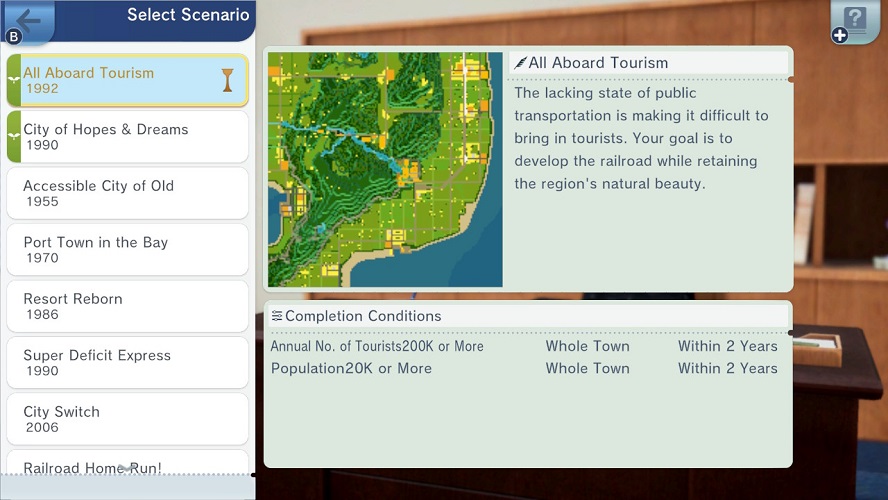
Upon opening the scenario selection screen you will find a list of official scenarios, any user-created scenarios downloaded, and the option to browse a catalogue of shared user-created scenarios. Next, we receive an overview of the map, a short written description of the selected scenario, and the completion conditions. Here you can see that on Normal difficulty the game expects us to grow the region’s population to at least 20,000 people and have at least 200,000 annual tourist visits within a time frame of two years.
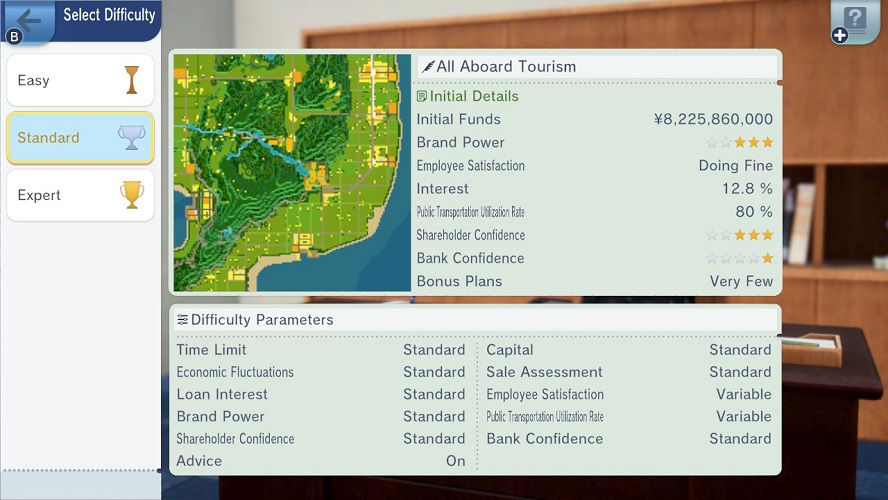
Progressing on to the difficulty selection screen we can now select our desired level of challenge. In A-Train: All Aboard! Tourism the difficulty level effects several parameters, as reflected on the UI when moving between the Easy, Standard and Expert options. Our choice of difficulty will modify our starting funds, initial company brand power, initial employee satisfaction, the initial interest rate of loans, starting shareholder confidence levels, starting bank confidence levels, economic volatility, value assessments when selling assets, whether the public transportation utilisation rate varies, and whether advisor advice is enabled.
You need not worry about managing advanced gameplay mechanics such as shareholder confidence and brand power on Easy difficulty as the value of these parameters will never drop below their maximum. Additionally, capital will be plentiful with generous starting funds and low interest bank loans available thanks to an economy that will only experience gentle economic fluctuation. However, if a complete dynamic simulation of economic and business conditions is your desire then the Standard and Expert difficulties are definitely for you.

Upon beginning the scenario we are greeted by a loading screen transporting us all the way back to April 1st, 1992. A-Train: All Aboard! Tourism retains the Epoch system introduced in A-Train 3D // A-Train PC Classic. Therefore, the time period of the scenario will influence which vehicles and buildings are available to us for construction or research, with additional options potentially appearing as time progresses. Additionally, the financially savvy out there might know that April 1st marks the beginning of a new fiscal period in Japan. Due to the importance of the fiscal year to the business management aspects of the game all scenarios in A-Train: All Aboard! Tourism commence on April 1st.
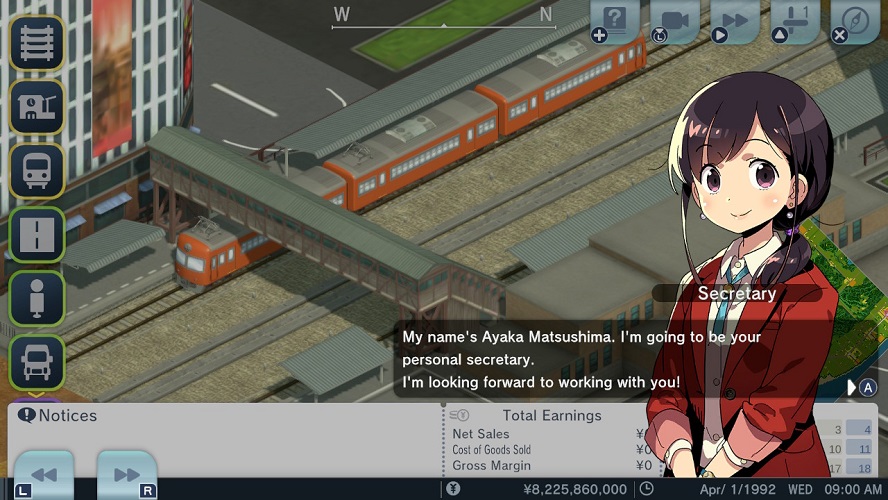
At beginning of each scenario we are greeted by our personal secretary, who will provide us with a basic introduction to the scenario. We commence our transportation adventure at Enomori Station, which is located near the coast and the north east border of the map. As outlined in the scenario description and completion conditions, our objective is to greatly expand the existing transportation infrastructure to help facilitate the growth of both tourism and population in the region.
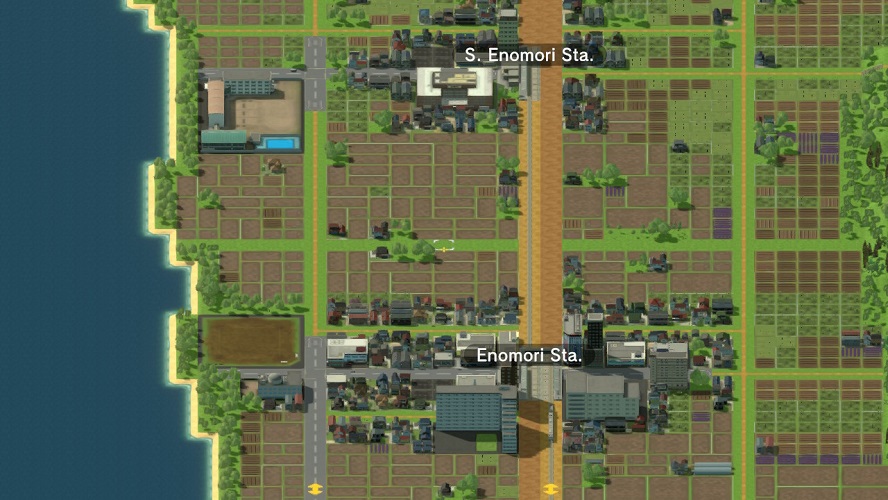
Currently our company has a single track built to the metropolis of Hasuoka, located off-map and accessible via our rail connection at the northern map border (bottom of picture), and operates the line using a single suburban class train. Our company also begins with a single track connecting Enomori Station, via a second platform, to South Enomori Station. However, we begin the scenario with no active train service in operation on the line. This is a problem that can be easily and quickly rectified though, with a second suburban class EMU (Electric Multiple Unit) currently located in company storage awaiting deployment.
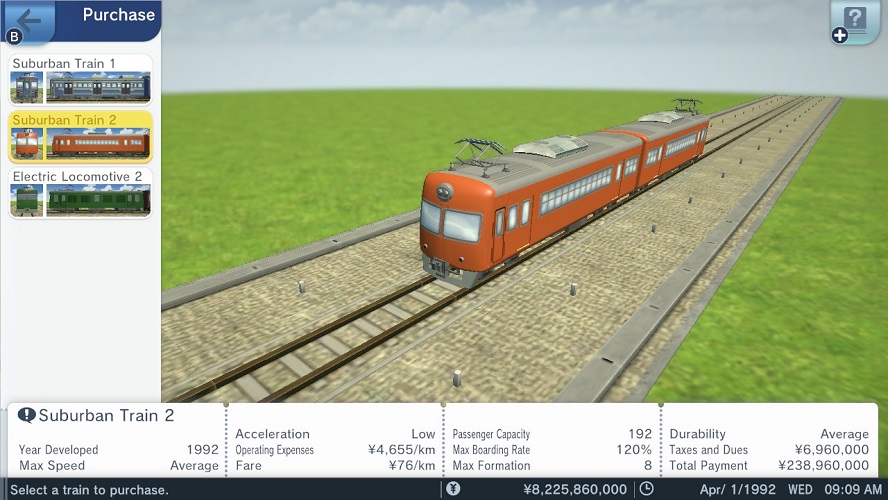
That wraps up this introduction to Let’s Play All Aboard Tourism. Hopefully, you will join me next time as we begin enacting our business plan for the region. Along the way learning all about tourism, a core feature of the game, and the nearby attraction of Nagashirojo Castle. Until the next time we met, have a safe journey!
I guess it’s time for me to fire this up again! I feel like I need to spend a bit more time researching track layouts and such. I kept getting hamstrung by colliding trains and stuck busses.
Also, it would be nice if you could load up either of the tutorial scenarios but skip the actual tutorial part.
That is largely what happens when you replay them on Normal or Expert difficulty. All the game features become available from the beginning and the tutorialisation is stripped out. Which I guess isn’t so helpful if you want to replay them on Easy difficulty, to be fair. So, a slight flaw there.
Ah! I did not know that. But it looks like the first actual scenario will fit the bill nicely: building up infrastructure and tourism in 1955.
Anyway, I am really looking forward to the continuation of your posts. I really like the game and feel like it’s something I could sink dozens (if not hundreds) of hours into, but I just need a bit more how-to help beyond the basic controls.
Oh, jeebus, this thread is going to suck me in, isn’t it? Thanks, @Malkael, you jerk! I dinked* around with A-Train 9 on Steam for a bit, but it sounds like I’m going to have to grab All Aboard Tourism for the Switch.
So this is my own particular quirk, but is there any external incentive to play harder difficulty levels? A scoring system? Unlockables? Ingame goals? Or am I choosing harder just for the sake of greater difficulty/complexity?
-Tom
* Get it?
Uh oh… On the DS version, there was nothing but bragging rights (and, well, a different game).
Anyway, I vote Malkael as QT3er of the Month already. The enthusiasm in the thread makes me ignore my old interface complaints for the Tourism game. It was all in the head :O
I agree with the kudos to @Malkael I don’t even own the game or a DS and I’m thinking “is there a version of this on Steam that I can play? “ my vague recollection recollection of A Train is that it’s always been a bit too obtuse but it sounds as though the series has come a long way.
There is a Steam version linked above, I just got the DS version because it’s cheaper.
I have ordered the Japanese physical edition of the Tourism one or whatever because I like hard cards. Just knowing no one can flip a switch and take my game away gives me a nice feeling. (Also, if my Switch ever breaks, and I can somehow obtain new hardware, I don’t have to worry about the eShop still being online in order to transfer the game to it. I can just pop the card in.)
Hopefully it includes English!
It does, game is awesome like that.
I think you’ll be disappointed to learn the save games aren’t stored on the cartridge anymore.
Gotta pay Nintendo 20 bucks a year, or lose all your progress!
Do you guys have a pro tip about how to charge your console next to bed? or play it plugged there?
